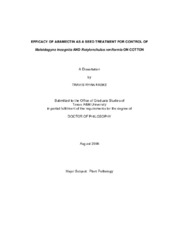| dc.description.abstract | Abamectin is a blend of B1a and B1b avermectins that is being used as a seed treatment to control plant-parasitic nematodes on cotton. Data on the toxicity of abamectin and its effectiveness as a seed treatment to control Meloidogyne incognita or Rotylenchulus reniformis on cotton are lacking. The toxicity of abamectin was based on an assay of nematode mobility, LD50 values of 1.56 µg/ml and 32.9 µg/ml were calculated based on 2 hr exposure for M. incognita and R. reniformis, respectively. There was no recovery of either nematode after exposure for 1 hr to its LD50 concentration. Sublethal concentrations greater than 0.39 µg/ml for M. incognita and 8.2 µg/ml for R. reniformis reduced (P = 0.05) infectivity on tomato. In field trials, suppression (P = 0.05) of M. incognita was observed 32 DAP by abamectin seed treatment whereas no suppression of R. reniformis was observed. No suppression of M. incognita was perceived by abamectin seed treatment in microplots. Suppression of M. incognita was observed in microplots by harpinEA and harpingαβ as a seed treatment and foliar spray, respectively. Seed cotton yields were variable for abamectin-treated seed, but numerically positive for harpin-treated cotton. Initial gall formation on developing taproots was suppressed (P = 0.001), and penetration of 5-cm long taproots by M. incognita and R. reniformis was numerically suppressed by abamectin-treated compared to non-treated seed, but infection increased with root development. Using an assay of nematode mobility, the proportion of dead second-stage juveniles (J2) was higher (P = 0.05) following exposure to an excised radicle from abamectin-treated seed than non-treated seed, but lower (P = 0.05) than J2 exposed to the abamectin-treated seed coat. Thus a higher concentration of abamectin remained on the seed coat than emerging radicle. The concentration of abamectin transferred from the seed coat to the developing roots was limited, which contributed to the variability in suppression of plant-parasitic nematodes on cotton. | en |


